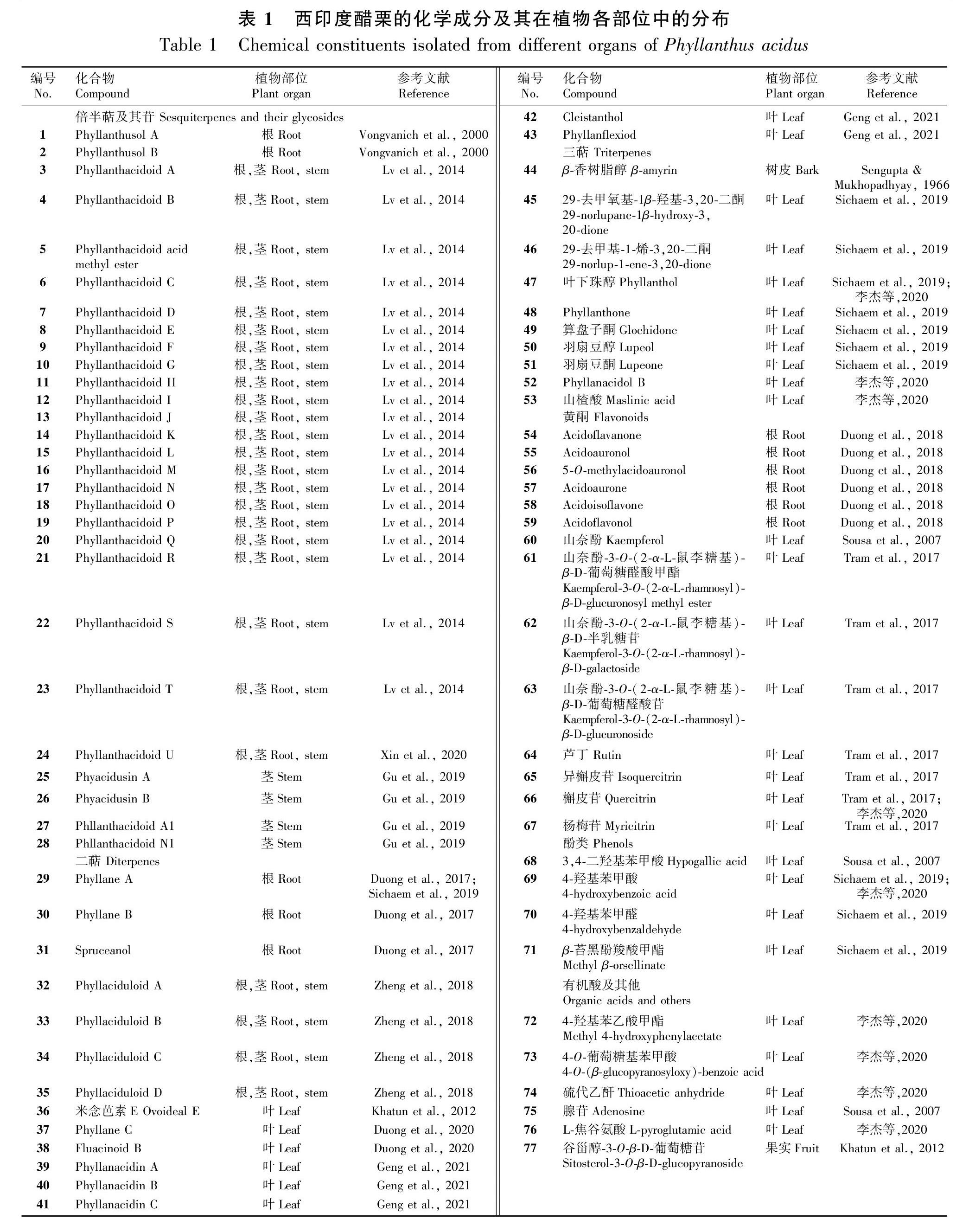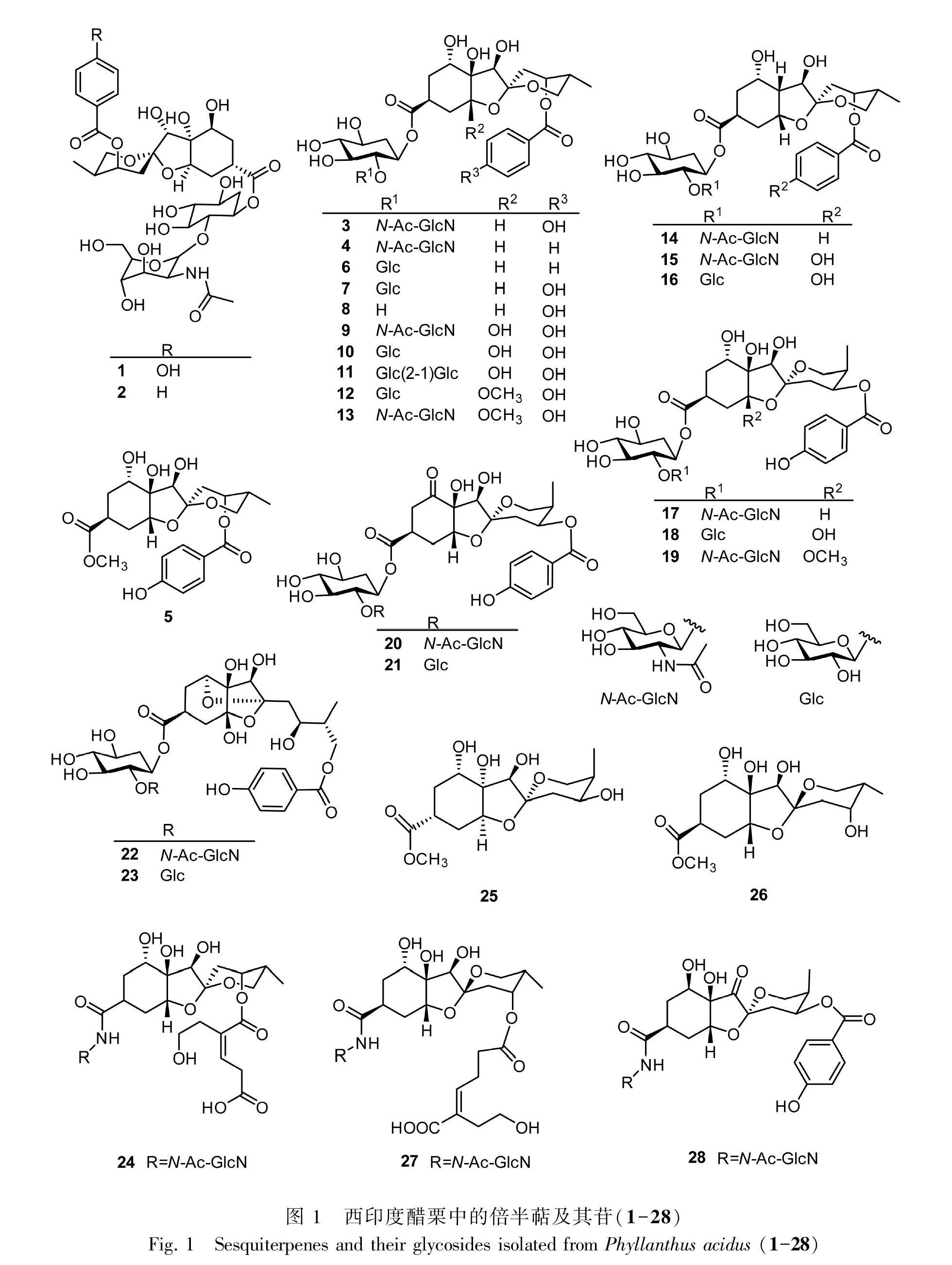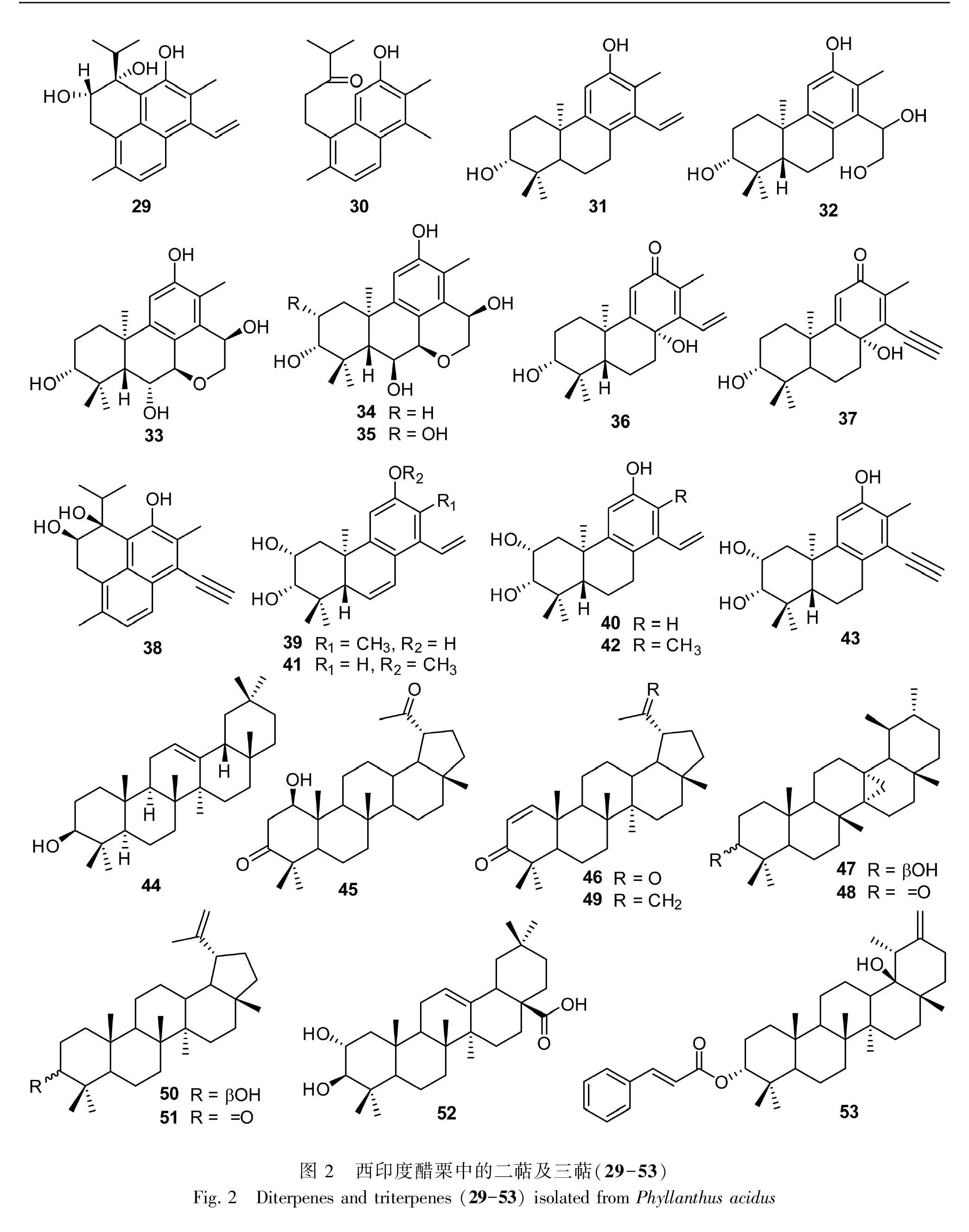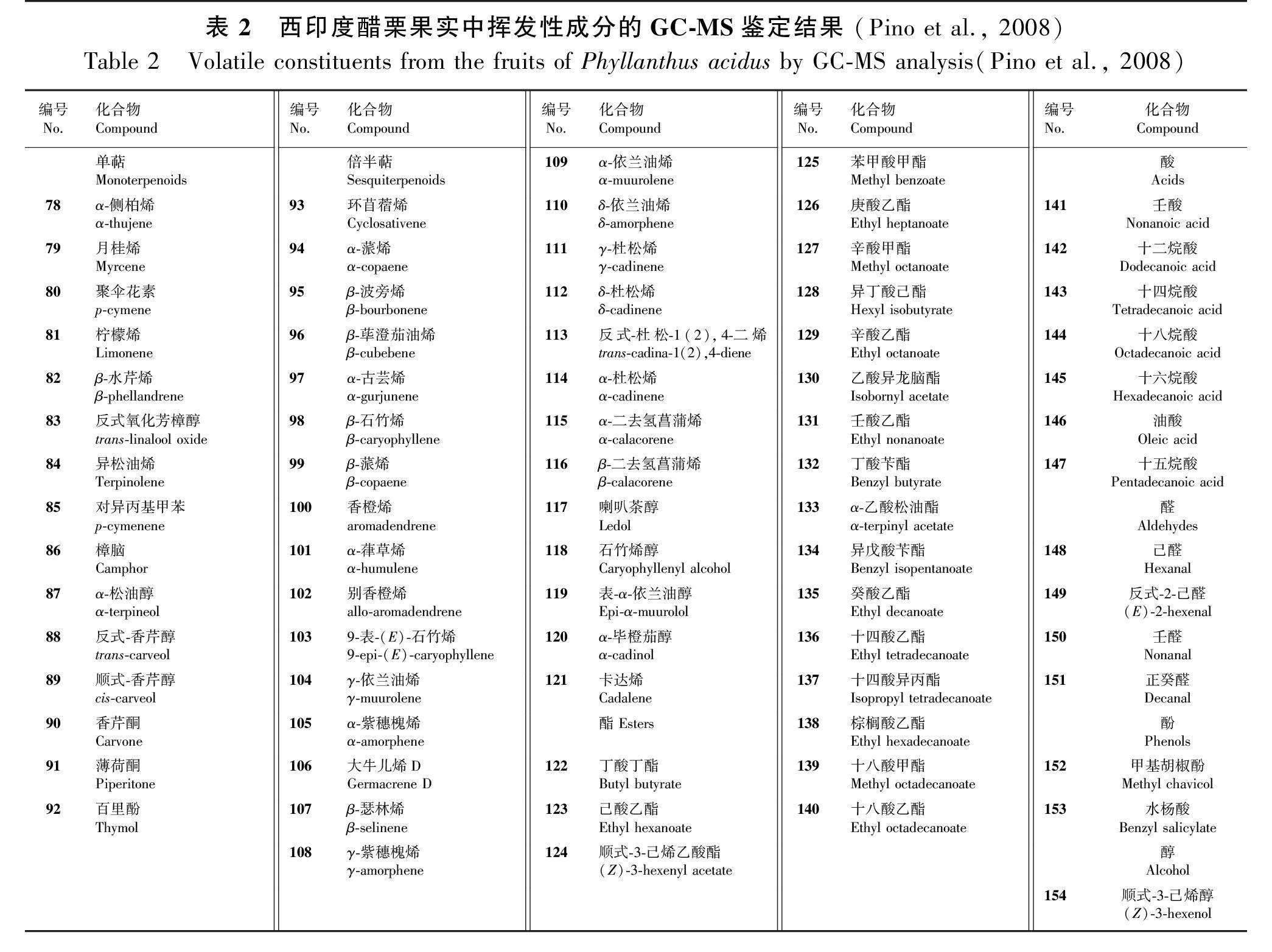西印度醋栗的化学成分及药理活性研究进展
2021-12-18胥佳李娜朱宏涛杨慰农王东杨崇仁张颖君
胥佳 李娜 朱宏涛 杨慰农 王东 杨崇仁 张颖君





摘 要: 西印度醋栗為大戟科叶下珠属常绿灌木或乔木,主产于泰国、越南、缅甸、老挝等地,中国云南西双版纳和元江有引种栽培。该植物果实可食用,枝叶、根茎、果实等在东南亚各国被广泛用于治疗高血压、哮喘、糖尿病、皮炎、发烧、天花等,印度尼西亚、泰国、印度等地区亦用其叶做蔬菜食用。有关其化学和药理活性研究,主要集中于根、茎和枝叶。根、茎主要含倍半萜、二萜和三萜,枝叶则主要为黄酮类成分。部分化合物显示有显著的抗乙肝病毒、抗菌、抗炎、保肝和降压等活性,其中,多个降没药烷型倍半萜对乙肝病毒(HBV)表面抗原(HBsAg)和e抗原(HBeAg)的IC50值为0.8~36 μmol·L-1,构效关系研究表明,倍半萜结构中C-5位的缩酮和C-13位的糖基取代可能对抗HBsAg和HBeAg的选择性有贡献。该文综述了1966—2020年西印度醋栗的化学成分和药理活性研究进展,为该植物的深入研究和开发利用提供科学参考和依据。
关键词: 西印度醋栗, 化学成分, 药理活性, 研究进展
中图分类号: Q946;R284.1
文献标识码: A
文章编号: 1000-3142(2021)11-1784-10
Research progress on chemical constituents and
pharmacological activity of Phyllanthus acidus
XU Jia1,2, LI Na1, ZHU Hongtao1, YANG Weinong3, WANG Dong1,
YANG Chongren1, ZHANG Yingjun1*
( 1. State Key Laboratory of Phytochemistry and Plant Resources in West China, Kunming Institute of Botany, Chinese Academy of Sciences,
Kunming 650201, China; 2. University of Chinese Academy of Sciences, Beijing 100049, China; 3. Yunnan Xinxing
Greening Engineering Co., Ltd., Kunming 650228, China )
Abstract: Phyllanthus acidus, an evergreen shrub or tree in Euphorbiaceae, is mainly distributed in Thailand, Vietnam, Myanmar, Laos, etc. It is also introduced and cultivated in Xishuangbanna and Yuanjiang areas of Yunnan Province, China. The fruits are edible and the plant has been widely used to treat various diseases, such as hypertension, asthma, diabetes, dermatitis, fever, smallpox, and so on, by the local people of its growing areas. Moreover, the young leaves are utilized as edible vegetables in Indonesia, Thailand and India. Phytochemical studies yielded sesquiterpenes, diterpenes and triterpenes from roots and stems, and flavonoids as the major chemical constituents from the leaves. Some constituents showed obvious anti-hepatitis B virus (HBV), anti-bacterial, anti-inflammatory, hepatoprotective and anti-hypertensive activities. For example, parts of the norbisabolane sesquiterpenes displayed potential anti-HBV activities, with IC50 values of 0.8-36 μmol·L-1 against HBV surface antigen (HBsAg) and HBV excreted antigen (HBeAg), and the results indicate that the ketal group at C-5 and sugar moieties at C-13 play important roles in the selectivity of HBsAg and HBeAg. This paper reviews the research progress of chemical constituents and pharmacological activities of the plant from 1966 to 2020, which provides scientific evidence and reference for its future study, spread, application and development.
Key words: Phyllanthus acidus, chemical constituents, pharmacological activity, research progress
西印度醋栗(Phyllanthus acidus)为大戟科叶下珠亚科叶下珠属植物,为常绿灌木或乔木,树高2~5 m,夏至秋季开花,花小、粉红色,开于老枝上,花后结青色小果。该物种起源于马达加斯加岛,后传到印度东部至菲律宾及附近岛屿,并逐渐分布到越南、印度尼西亚等地。目前,主要分布于泰国、印度、越南、巴西等热带、亚热带国家和地区。我国云南西双版纳和元江有引种栽培。在泰国传统用药中,西印度醋栗根可退热和治疗皮炎,叶用于治疗高血压,茎皮能治疗女性月经期发热,果实具有抗炎、抗氧化功效。菲律宾北部、波多黎各、越南等地称之为“Chum-ruot”,主要用于治疗哮喘、肝病、糖尿病、淋病等(Thyagarajan et al., 1988;赵永华和丁赢,2000;Jain & Singhai, 2011;罗丹丹等,2017; Tram et al., 2017)。
从西印度醋栗的根茎、叶和果实中共报道了77个化合物,包括28个倍半萜、15个二萜、10个三萜、14个黄酮、4个简单酚类、6个有机酸及其他类型化合物(表1,图1-图3)。其中,萜类是其主要化学成分,部分化合物具有显著的抗肿瘤细胞毒、抗乙肝病毒(HBV)、抗氧化、保肝、抗菌等多方面的生物活性。本文以植物部位为线索,对西印度醋栗的民间应用、化学成分和药理活性研究进展进行了综述,为该植物的进一步研究推广和深入挖掘利用提供科学参考。
1 根、茎和树皮
在印度,西印度醋栗的根可用作泻药(Watt, 1892)。文献报道,根皮、枝叶有毒,会引起头痛、嗜睡、剧烈腹痛和死亡(Caius, 1939)。在泰国,西印度醋栗的根常被用于酒精成瘾者的康复。据报道,该植物对治疗酒精成瘾非常有效,但也存在较大副作用,容易引发慢性疾病(Vongvanich et al., 2000)。泰国药用词典第五版中西印度醋栗的根用于退热和治疗皮炎(Teingburanathum, 1999)。
西印度醋栗的化学成分研究始于1966年,印度学者Sengupta & Mukhopadhyay(1966)从干燥的西印度醋栗树皮的苯提取物中分离得到1个五环三萜类化合物,β-香树脂醇(β-amyrin,44)(图2)。泰国学者Vongvanich et al.(2000)从该植物根的甲醇提取物中分离鉴定了2个倍半萜类成分,为具有N-乙酰化甘露糖基的降没药烷型倍半萜苷,分别命名为phyllanthusols A(1)和B(2)(图1)。生物活性研究表明,1和2对人淋巴细胞(BC)和人口腔表皮样癌细胞(KB)具有细胞毒性,EC50值均为0.3 μmol·L-1。
中国科学院昆明植物研究所学者从产自泰国的西印度醋栗的根和茎的甲醇提取物中分离得到21个化合物,均为降没药烷型倍半萜及其苷,其中也包括了泰国学者报道的2个化合物:phyllanthusols A(1)和B(2),是該植物根中的主要倍半萜类成分。进一步详细的2D NMR和耦合常数分析以及酸水解研究发现,1和2的外侧糖基应该为β-glucosamine-N-acetate,而非泰国学者报道的mannosamine-N-acetate。该研究对1和2的化学结构进行了修订,为避免混淆,将这两种化合物重新命名为phyllanthacidoids A(3)和B(4),19个新化合物分别命名为phyllanthacidoid acid methyl ester(5)和phyllanthacidoids C-T(6-23)(Lv et al., 2014)(图1)。其中,phyllanthacidoid acid methyl ester(5)、phyllanthacidoids A-D(3,4, 6,7)、F-I(9-12)和M(16)均显示出潜在的抗HBV活性,对HBV表面抗原(HBsAg)和e抗原(HBeAg)的IC50值为0.8~36 μmol·L-1。构效关系研究表明,倍半萜结构中C-5位的缩酮基团和C-13位的糖基取代可能对HBsAg和HBeAg的选择性有贡献。该研究组还从西印度醋栗根茎中报道了4个新的二萜phyllaciduloids A-D(32-35)(Zheng et al., 2018)和1个新的降A-D(32-35)对五种人肿瘤细胞株(白血病HL-60、肺癌A-549、肝癌SMMC-7721、乳腺癌MCF-7和结肠癌SW480)均未显示出明显的细胞毒活性。
Duong et al.(2017)从西印度醋栗根的乙醇提取物中发现了2个新的二萜phyllanes A(29)和B(30),以及其前体二萜spruceanol(31)(图2)。其中,30对人慢性髓系白血病细胞(K562)和人肝癌细胞系(HepG2)表现出抑制作用,IC50值分别为28.90和45.23 μmol·L-1。此外,还报道了6个新的含磺酸基的黄酮类化合物,acidoavanone(54)、acidoauronol(55)、5-O-methylacidoauronol(56)、acidoaurone(57)、acidoisoavone(58)和acidoavonol(59)(图3)。Duong et al.(2018)对54进行了活性筛选:以阿霉素作为阳性对照,采用MTT法对人肝癌细胞系(HepG2)和人乳腺癌细胞(MCF-7)进行了体外细胞毒性研究,没有发现54对这些癌细胞具有明显的抑制作用。
Gu et al.(2019)从中国云南西双版纳产的西印度醋栗的茎中分离鉴定了4个新的倍半萜,phyacidusins A和B(25,26)以及phllanthacidoids A1和N1(27,28)。其中,26对HBV表面抗原(HBsAg)的IC50值为(11.2±0.01) μmol·L-1,27对HBV的e抗原的IC50值为(57.1±0.02) μmol·L-1。结果丰富了抗HBV降倍半萜类化合物的分子多样性。
到目前为止,从西印度醋栗的根、茎和树皮中共报道了42个化合物,包括28个倍半萜(1-28)、7个二萜(29-35)和1个三萜(44),以及6个黄酮(54-59)。
2 枝叶
在印度传统医学中西印度醋栗的叶用于治疗发烧、痔疮、天花、瘙痒和牙龈感染(Jain et al., 2011)。孟加拉国的部落医生采用西印度醋栗的叶熬制制成汤剂用来治疗肝病(Chowdhary et al., 2008)。在泰国传统医药中西印度醋栗叶用作抗高血压的药物,用于缓解高血压引起的头痛(Teingburanathum, 1999)。在印度尼西亚、泰国和印度等地区,西印度醋栗的嫩叶亦被用作蔬菜食用(Prasad, 1986)。
Sousa et al.(2007)从西印度醋栗叶的水提物中分离得到了3个化合物,分别为山奈酚(kaempferol,60)、hypogallic acid(68)和腺苷(adenosine,75)(图3)。Tram et al.(2017)从该植物叶的甲醇和乙酸乙酯混合提取物中分离得到7个黄酮苷类成分,其中kaempferol-3-O-(2-α-L-rhamnosyl)-β-D-glucuronosyl methyl ester(61)为新化合物,其余6个分别鉴定为kaempferol-3-O-(2-α-L-rhamnosyl)-β-D-galactoside(62)、kaempferol-3-O-(2-α-L-rhamnosyl)-β-D-glucuronoside(63)、芦丁(rutin,64)、异槲皮苷(isoquercitrin,65)、槲皮苷(quercitrin,66)和杨梅苷(myricitrin,67)(图3)。对分离得到的黄酮苷类成分进行生物活性测试,发现化合物62具有抗氧化活性,63可通过抑制TNF-α和IL-6产物表现出抗炎活性,新化合物61具有肝保护活性。Sichaem et al.(2019)从西印度醋栗枝叶的甲醇提取物中报道了1个新的三萜:29-去甲氧基-1β-羟基-3,20-二酮(29-norlupane-1β-hydroxy-3,20-dione,45),以及10个已知化合物,包括6个三萜:29-去甲基-1-烯-3,20-二酮(29-norlup-1-ene-3,20-dione,46)、叶下珠醇(phyllanthol,47)、phyllanthone(48)、算盘子酮(glochidone,49)、羽扇豆醇(lupeol,50)、羽扇豆酮(lupeone,51),3个酚性化合物:4-羟基苯甲酸(4-hydroxybenzoic acid,69)、4-羟基苯甲醛(4-hydroxybenzaldehyde,70)、 β-苔黑酚羧酸甲酯(methyl β-orsellinate,71)和1个二萜:phyllane A(29)。抗氧化活性测试发现,70对DPPH具有良好的自由基清除活性,IC50值为2.63 μg·mL-1。化合物29曾被Duong et al.(2017)从该植物根的乙醇提取物中亦分离得到。李杰等(2020)从西印度醋栗叶的甲醇提物中亦分离得到了1个新的三萜phyllanacidol B(52)和9个已知化合物,分别为米念芭素E(ovoideal E,36)、叶下珠醇(phyllanthol,47)、山楂酸(maslinic acid,53)、槲皮苷(quercitrin,66)、4-羟基苯甲酸(4-hydroxybenzoic acid,69)、4-羟基苯乙酸甲酯(methyl 4-hydroxyphenylacetate,72)、4-O-葡萄糖基苯甲酸 [4-O-(β-glucopyranosyloxy)-benzoic acid,73]、硫代乙酐(thioacetic anhydride,74)和L-焦谷氨酸(L-pyroglutamic acid,76)。除47、66和69外,其余化合物均为首次从西印度醋栗中分离得到。Sousa et al.(2007)研究发现西印度醋栗叶的水提物对治疗囊性纤维症有一定的作用。Duong et al.(2020)还从西印度醋栗叶的甲醇提取物中发现了一个新的二萜phyllane C(37)和3个已知化合物:ovoideal E(36)、spruceanol(31)和fluacinoid B(38),其中化合物37的结构中具有一个末端乙炔基,这在自然界中是非常罕见的。中国科学院昆明植物研究所的Geng et al.(2020)从西印度醋栗叶的乙醇提取物中发现3个新的二萜phyllanacidins A-C(39-41)和3个已知化合物:cleistanthol(42)、phyllanflexiod(43)和spruceanol(31),其中化合物40和41是首次发现的C-17位丢失甲基的降二萜,可能是由31经过关键的氧化脱羧反应形成的。此外,42、43和31均表现出显著的细胞毒活性,IC50值为16.11~30.82 μg·mL-1(Geng et al., 2020)。
从西印度醋栗的枝叶中共分离报道了36个化合物,包括9个三萜(45-53)、10个二萜(29,31,36-43)、8个黄酮(60-67)、4个酚性化合物(68-71)、3个有机酸(72-74)、1个核苷(75)和1个氨基酸衍生物(76)。
3 果实
西印度醋栗果实可以食用,在印度传统医学中是一种肝脏滋补剂和血液净化剂,用于治疗黄疸、支气管炎、便秘、呕吐、泌尿系统结石、痔疮以及肝病等(Kirtikar & Basu, 1987)。
有关西印度醋栗果实的化学成分研究报道较少,且主要集中于挥发性成分。Quijano et al.(2007)通过GC-FID和GC-MS技术,分别对发酵1個月、3个月和6个月后的西印度醋栗果实中挥发性成分进行分析,共检测到46个挥发性成分,发现随着发酵时间的增加,许多成分的含量发生了变化。发酵初期酸和醇类化合物是其主要成分,而发酵6个月之后,酸类化合物成为主要成分。倍半萜的含量也发生显著的变化,发酵3个月之后,δ-cadinene和α-cadinene的含量显著增加;6个月之后,α-cadinol和t-muurolol的含量显著增加。哈瓦那的研究人员用乙醚进行蒸馏萃取,并采用GC-MS分析,从西印度醋栗的果实中报道了77个挥发油成分(表2),包括45个萜烯类,18个酯类,7个酸类,4个醛类,2个酚类和1个醇类成分(Pino et al., 2008)。挥发油的总含量约为109 mg·kg-1,其中萜烯(100.1 mg·kg-1)和酸(6.7 mg·
kg-1)占主导地位,为其主要成分。在萜烯类化合物中有许多单萜和倍半萜烯类成分,主要代表性成分为epi-α-muurolol(32.9 mg·kg-1)和α-cadinol(22.1 mg·kg-1)。Hexadecanoic acid(3.8 mg·kg-1)是酸中的主要化合物。Khatun et al.(2012)从西印度醋栗果实的石油醚提取物中分离得到了1个甾醇葡萄糖苷:谷甾醇-3-O-β-D-葡萄糖苷(sitosterol-3-O-β-D-glucopyranoside,77)。
研究发现,西印度醋栗的果实提取物具有一定的抗氧化活性。Sulaiman & Ooi(2014)发现该植物果实水提物具有抗氧化活性,采用DPPH和FRAP模型,以总酚和维生素C作为阳性对照,每克西印度醋栗果实水提物的抗氧化能力与(613.71±2.59) mg维生素C和(2 784.89±3.93) μg维生素E的作用相当。Moniruzzaman et al.(2015)测定了西印度醋栗果实甲醇提取物的抗氧化活性:其清除DPPH和羟自由基、抑制脂质过氧化以及金属螯合活性的IC50值分别为16、60、472和309 μg·mL-1。Pradeep et al.(2018)的研究也发现西印度醋栗果实的乙酸乙酯和甲醇提取物在500 μg·mL-1时,其对DPPH、ABTS+、过氧化氢和NO的清除率和抑制率都在90%以上。
西印度醋栗果实亦具有一定的抗菌活性。Melendez & Capriles(2006)在筛选抗菌药用植物时,发现西印度醋栗果实的甲醇提取物具有广谱的抗菌活性。Rahman et al.(2011)采用圆盘扩散法,测试了西印度醋栗甲醇提取物对13种微生物抗菌活性,发现其对痢疾链球菌(Streptococcus dysenteriae)、枯草芽孢杆菌(Bacillus subtilis)、巨大芽孢杆菌(B. megaterium)有一定的抑制作用,其中对枯草芽孢杆菌的抑制作用最强。采用同样的方法,Habib et al.(2011)测试西印度醋栗果实氯仿提取物对11种微生物的抗菌活性,发现其对痢疾链球菌和金黄色葡萄球菌(Staphylococcus aureus)具有一定的抑制作用,其中对痢疾链球菌的抑制作用最强;Padmapriya & Poonguzhali(2015)测试了西印度醋栗丙酮提取物对大肠杆菌(Escherichia coil)、铜绿假单胞菌(Pseudomonas aeruginosa)、蜡状芽孢杆菌(Bacillus cereus)和金黄色葡萄球菌的抑制效果,发现平均抑制范围在13~20 mm之间,其中对大肠杆菌和铜绿假单胞菌的抑制率最高,分别达到19和20 mm。
Jain & Singhai(2011)发现西印度醋栗果实的70%乙醇提取物对四氯化碳诱导的大鼠肝脏急性氧化损伤有显著的保护作用。与对照组相比,西印度醋栗果实提取物可减少大鼠血清中的谷草转氨酶(aspartate transaminase,AST)、谷丙转氨酶(alanine transaminase,ALT)和碱性磷酸酶(alkaline phosphatase,ALP)水平,以及脂质过氧化(lipid peroxidation,LPO),同时增加血清中总蛋白(total protein,TP)、谷胱甘肽(glutathione,GSH)、超氧化物歧化酶(superoxide dismutase,SOD)、过氧化氢酶(catalase,CAT)以及谷胱甘肽过氧化物酶(glutathione peroxidase,GPx)的水平,该提取物还可缩小hexobarbitone(一种巴比妥类药物,具有催眠效果)诱导的睡眠时间。研究表明,西印度醋栗的肝保护作用可能与其抗氧化和清除自由基能力有关。
西印度醋栗还具有其他方面的生物活性。例如:200 mg·mL-1果汁具有显著体外α-葡萄糖苷酶抑制活性,抑制率达(95.73±0.15)%(Sulaiman & Ooi,2014);果实水提物对血管紧张素有一定的抑制活性,在20 μg·mL-1浓度下的抑制率为(79.73±1.97)%,阳性对照赖诺普利(一种抑制剂)在13 μg·mL-1浓度下的抑制率为(99.29±1.11)%(Das & De,2013);Leeya et al.(2010)研究表明,西印度醋栗的降压作用可能直接在血管
介导,引起血管舒张;Chongsa et al.(2014)研究表明西印度醋栗水提物对脂质代谢有影响,可导致血清脂质、内脏和皮下脂肪的减少,具有减肥功效;Gurushantha et al.(2015)研究表明,使用西印度醋栗生物质作为燃料,通过简便、环保、廉价的生物方法溶液燃烧途径合成立方ZrO2具有很大的潜能。
4 讨论与结论
迄今为止,有关西印度醋栗的研究主要集中于根、茎、树皮和枝叶,从中共分离报道了77个化合物,主要为三萜、二萜、倍半萜和黄酮类成分,部分化合物显示有较强的保肝、抗癌、抗炎、抗氧化等活性。這些活性与西印度醋栗的传统用途相符,表明该植物的根、茎和枝叶有一定的药用价值。然而,目前的药理活性研究大多限于体外细胞水平,有待进一步的动物体内和临床研究。同时,西印度醋栗叶被部分地区用作蔬菜,其安全性有待阐明。
西印度醋栗在热带、亚热带国家和地区的民间有较广泛的应用,近年也在中国云南的部分地区引种栽培。该植物果实提取物具有抗氧化、抗菌、减肥、降压、保肝等多方面的生物活性,但相关化学成分研究尚较少,且主要为挥发性成分。根据已有的化学和药理活性研究结果,可在适宜地区进行推广。同时,进一步深入研究和阐明其生态学意义、化学成分及生物活性物质,将有助于该植物资源的深入挖掘和推广利用,并为新药研发提供分子基础。
參考文献:
CAIUS JF, 1939. Medicinal and poisonous spurges of India [J]. J Bombay Nat Hist Soc, 40: 265-313.
CHONGSA W, RADENAHMAD N, JANSAKUL C, 2014. Six weeks oral gavage of a Phyllanthus acidus leaf water extract decreased visceral fat, the serum lipid profile and liver lipid accumulation in middle-aged male rats [J]. J Ethnopharmacol, 155(1): 396-404.
CHOWDHARY Z, ALAMGIR ANM, ALAUDDIN M, et al., 2008. Traditional knowledge related to medicinal and aromatic plants in tribal societies and the quantitative study of alkaloids in medicinal plants of the hill tracts in Bangladesh [J]. Pharma Mag, 4: S137-S144.
DAS S, DE B, 2013. Evaluation of angiotensin I-converting enzyme (ACE) inhibitory potential of some underutilized indigenous fruits of West Bengal using an in vitro model [J]. Food Feed Chem, 68(6): 499-506.
DUONG T, BENIDDIR MA, NGUYEN V, et al., 2018. Sulfonic acid-containing flavonoids from the roots of Phyllanthus acidus [J]. J Nat Prod, 81(9): 2026-2031.
DUONG T, BUI X, POGAM PL, et al., 2017. Two novelditerpenes from the roots of Phyllanthus acidus (L.) Skeel [J]. Tetrahedron, 73(38): 5634-5638.
DUONG TH, NGUYEN TT, DANG CT, et al., 2020. A new diterpenoid from the leaves of Phyllanthus acidus [J]. Nat Prod Res, (4): 1-7.
GENG HC, ZHU HT, WANG D, et al., 2021. Phyllanacidins A-C, three new cleistanthane diterpenoids from Phyllanthus acidus and their cytotoxicities [J]. Fitoterapia, 148: 104793.
GU C, YIN AP, YUAN HY, et al., 2019. New anti-HBV norbisabolane sesquiterpenes from Phyllanthus acidus [J]. Fitoterapia, 137: 104-151.
GURUSHANTHA K, ANANTHARAJU KS, NAGABHUSHANA H, et al., 2015. Facile green fabrication of iron-doped cubic ZrO2 nanoparticles by Phyllanthus acidus: structural, photocatalytic and photoluminescent properties [J]. J Mol Catal A-Chem, 397: 36-47.
HABIB MR, RAHMAN MM, MANNAN A, et al., 2011. Evaluation of antioxidant, cytotoxic, antibacterial potential and phytochemical screening of chloroform extract of Phyllanthus acidus [J]. Int J Appl Biol Pharm Technol, 2(1): 420-427.
JAIN NK, SINGHAI AK, 2011. Protective effects of Phyllanthus acidus (L.) Skeels leaf extracts on acetaminophen and thioacetamide induced hepatic injuries in wistar rats [J]. Asian Pac J Trop Med, 4(6): 470-474.
KHATUN M, BILLAH M, QUADER MA, 2012. Sterols and sterol glucoside from Phyllanthus species [J]. Dhaka Univ J Sci, 60(1): 5-10.
KIRTIKAR KR, BASU BD, 1987.Indian medicinal plants [M]. Allahabad: Lalit Mohan Basu.
LEEYA Y, MULVANY MJ, QUEIROZ EF, et al., 2010. Hypotensive activity of an n-butanol extract and their purified compounds from leaves of Phyllanthus acidus (L.) Skeels in rats [J]. Eur J Pharmacol, 649(1): 301-313.
LI J, LI ZL, JIA RF, et al., 2020. A new triterpene isolated from leaves of Phyllanthus acidus [J]. Chin Trad Herb Drugs, 51(3): 571-575. [李杰, 李振麟, 贾瑞芳, 等, 2020. 西印度醋栗叶中1种新三萜的分离与鉴定 [J]. 中草药, 51(3): 571-575.]
LUO DD, GU T, LI XW, et al., 2017. Analysis of varieties and standards of Euphorbiaceae medicinal plants used in Dai medicine [J]. Trad Chin Drug Res Clin Pharmacol, 28(5): 692-698. [羅丹丹, 顾婷, 李西文, 等, 2017. 傣医学药用大戟科植物药材品种与标准的现状分析 [J]. 中药新药与临床药理, 28(5): 692-698.]
LV JJ, YU S, WANG YF, et al., 2014. Anti-hepatitis B virus norbisabolane sesquiterpenoids from Phyllanthus acidus and the establishment of their absolute configurations using theoretical calculations [J]. J Org Chem, 79(12): 5432-5447.
MELENDEZ PA, CAPRILES VA, 2006. Antibacterial properties of tropical plants from Puerto Rico [J].Phytomedicine, 13(4): 272-276.
MONIRUZZAMAN M, ASADUZZAMAN M, HOSSAIN MS, et al., 2015. In vitro antioxidant and cholinesterase inhibitory activities of methanolic fruit extract of Phyllanthus acidus [J]. BMC Complement Altern Med, 15(1): 403.
PADMAPRIYA N, POONGUZHALI TV, 2015. Antibacterial and antioxidant potential of the acetone extract of the fruit of Phyllanthus acidus [J]. Int J Curr Res, 17: E64-E72.
PINO JA, CUEVAS-GLORY LF, MARBOT R, et al., 2008. Volatile compounds of grosella [Phyllanthus acidus (L.) Skeels] fruit [J]. Rev CENIC Cienc Quim, 39(1): 2-4.
PRADEEP CK, SUNILKUMAR CR, SWATI K, et al., 2018. Evaluation of in vitro antioxidant potential of Phyllanthus acidus fruit [J]. Res J Life Sci, Bioinf, Pharm Chem Sci, 4(6): 31.
QUIJANO CE, LINARES D, PINO JA, 2007. Changes in volatile compounds of fermented cereza agria [Phyllanthus acidus (L.) Skeels] fruit [J]. Flavour Frag J, 22(5): 392-394.
RAHMAN MM, HABIB MR, HASAN SR, et al., 2011. Antibacterial, cytotoxic and antioxidant potential of methanolic extract of Phyllanthus acidus L. [J]. Int J Drug Dev Res, 3(2): 154-161.
PRASAD D, 1986. Edible fruits and vegetables of the English-speaking Caribbean [M]. Kingston, Jamaica: Food and Nutrition Institute: 75.
SENGUPTA P, MUKHOPADHYAY J, 1966. Terpenoids and related compounds-Ⅶ: triterpeneoids of Phyllanthus acidus Skeels [J]. Phytochemistry, 5(3): 531-534.
SICHAEM J, VO HC, NHA-TRAN T, et al., 2019. 29-Norlupane-1β-hydroxy-3,20-dione, a newnorlupane triterpenoid from the twigs and leaves of Phyllanthus acidus [J]. Nat Prod Res, http://doi.org/10.1080/14786419.2019.1700252.
SOUSA M, OUSINGSAWAT J, SEITZ R, et al., 2007. An extract from the medicinal plant Phyllanthus acidus and its isolated compounds induce airway chloride secretion: A potential treatment for cystic fibrosis [J]. Mol Pharmacol, 71(1): 366-376.
SULAIMAN SF, OOI KL, 2014. Antioxidant and α-glucosidase inhibitory activities of 40 tropical juices from Malaysia and identification of phenolics from the bioactive fruit juices of Barringtonia racemosa and Phyllanthus acidus [J]. J Agric Food Chem, 62(39): 9576-9585.
TEINGBURANATHUM V, 1999. Thai Medicinal Plant Dictionary [M]. 5th ed. Bangkok: Roumsarn Press.
THYAGARAJAN SP, THIRUNALASUNDARI T, SUBRAMANIAN S, et al., 1988. Effect of Phyllanthus amarus on chronic carriers of hepatitis B virus [J]. Lancet, 332(8614): 764-766.
TRAM NCT, NGA NT, PHUONG VTT, et al., 2017. The hepatoprotective activity of a new derivative kaempferol glycoside from the leaves of Vietnamese Phyllanthus acidus (L.) Skeels [J]. Med Chem Res, 26(9): 2057-2064.
VONGVANICH N, KITTAKOOP P, KRAMYU J et al., 2000. Phyllanthusols A and B, cytotoxic norbisabolane glycosides from Phyllanthus acidus Skeels [J]. J Org Chem, 65(17): 5420-5423.
WATT G, 1892. Dictionary of the economic products of India. Vol. VI, Part 1 [M]. W. H. Allen & Co.
XIN Y, XU M, WANG YF, et al., 2020. Phyllanthacidoid U: A new N-glycosyl norbisabolane sesquiterpene from Phyllanthus acidus (L.) skeels [J]. Nat Prod Res, https://doi.org/10.1080/ 14786419.2020.1712387.
ZHAO YH, DING Y, 2000. Development andutilization of medicinal plant resources of Phyllanthus in China [J]. Bull Biol, 35(12): 39-40. [趙永华, 丁赢, 2000. 我国叶下珠属药用植物资源的开发利用 [J]. 生物学通报, 35(12): 39-40.]
ZHENG XH, YANG J, LV JJ, et al., 2018. Phyllaciduloids A-D: Four new cleistanthane diterpenoids from Phyllanthus acidus (L.) Skeels [J]. Fitoterapia, 125: 89-93.
(责任编辑 周翠鸣)
